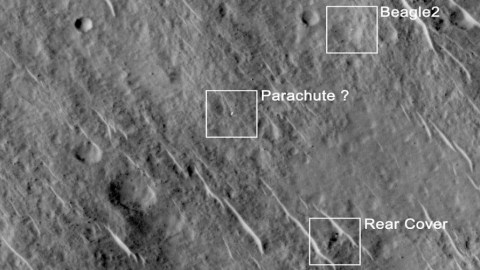Lost Beagle 2 Spacecraft Found Intact on Mars Surface

NASA’s Mars Reconnaissance Orbiter has located the British spacecraft Beagle 2 on the Martian surface, eleven years after contact with the probe was lost. The discovery also revealed the apparent cause of the mission’s unfortunate end. Jonathan Amos of BBC News reports:
“Beagle’s design incorporated a series of deployable ‘petals,’ on which were mounted its solar panels.
From the images, it seems that this system did not unfurl fully.
‘Without full deployment, there is no way we could have communicated with it as the radio frequency antenna was under the solar panels,’ explained Prof Mark Sims, Beagle’s mission manager from Leicester University.
‘The failure cause is pure speculation, but it could have been, and probably was, down to sheer back luck – a heavy bounce perhaps distorting the structure as clearances on solar panel deployment weren’t big; or a punctured and slowly leaking airbag not separating sufficiently from the lander, causing a hang-up in deployment,’ he told BBC News.”
The spacecraft, named after the ship that twice carried Charles Darwin across the seas, reached the Martian surface on Christmas Day, 2003. Unfortunately for European Space Agency scientists, the jolly holiday was soon mired by the sad news that there was no communication between Beagle 2 and mission control. The lost mission was especially difficult for Colin Pillinger, the English planetary scientist who was the public face of the mission. Perhaps most sad is that Pillinger died this past May never knowing what became of his beloved Beagle 2.
Read more at BBC News





